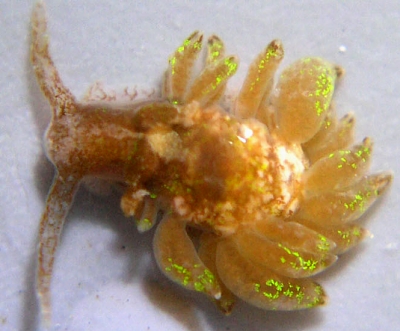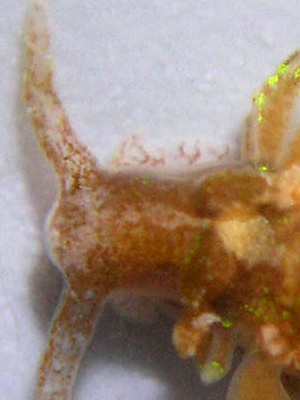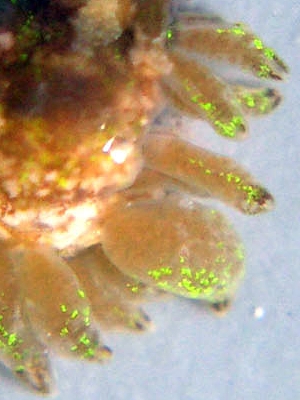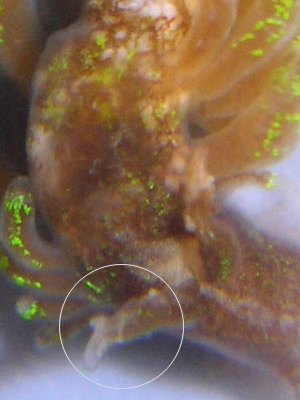Perhaps a gorgonian feeder?
August 25, 2006
From: Jon Humphreys

Hi there,
I recently found what I believe to be a nudibranch in my reef aquarium. It was perched on the tip of a gorgonian just after the main lights came on in the tank and one hour after the actinics had been on. I'm not sure if it's important, but it happened to be perched on the tip of the gorgonian where I had recently broken off a fragment.
I removed it via siphon and tooks some images of it in hopes you can ID it. It appears to be about 4.5mm in length. If it's not predacious, I'd love to keep it in my tank.
Locality: Aquarium, Less than 1m, California, USA, Aquarium, 15 Aug 2006 PDT, Perched on tip of octocoral. Length: Approx 4.5 mm. Photographer: Jon Humphreys.
Thanks for any insight,
Jon
jon@dogs-breakfast.com



Dear Jon,
It is certainly an aeolid nudibranch but not one I recognise. The only gorgonian feeding aeolids belong to the genus Phyllodesmium. Many species of the genus are solar-powered through their removal of zooxanthellae from the soft-corals they feed on. Your animal has a brown network on the foot and body, which suggests that it may have modified digestive gland ducts to harbour zooxanthellae. However species of Phyllodesmium lack cnidosacs, but in your photos there seem to be obvious cnidosacs at the tip of the cerata, so it is unlikely your animal is a Phyllodesmium.
One other possibility is that your aeolid belongs to the family Aeolidiidae, like the species of Aeolidiopsis which feed on Palythoa. In the lower right photo I have ringed one of the rhinophores, which seem to have little tubercles or branches. Species of Aeolidiopsis have branched rhinophores.
I may be wrong but I suspect your animal is not eating your gorgonian but it may be eating Palythoa, if you have any in your aquarium. I know you will probably just want to squash it, but unless it is part of a large population in your aquarium, it shouldn't do much harm on its own. I would very much like to know if it grows much bigger, and what it actually eats, before you kill it.
Best wishes,
Bill Rudman
Related messages
-
Re: Polyp-feeding nudibranch
From: erik, April 20, 2007 -
Aeolidiopsis sp. in aquarium
From: Scott Smith, March 13, 2007 -
Re: Polyp-feeding nudibranch
From: Jack Kryppy, November 7, 2006 -
Re: Polyp-feeding nudibranch
From: David Sherrer, October 27, 2006 -
Re: Perhaps a gorgonian feeder?
From: Leslie Harris, August 26, 2006 -
Re: Perhaps a gorgonian feeder?
From: Jon Humphreys, August 26, 2006 -
Polyp-feeding nudibranch
From: Mark Johnson, December 7, 2002 -
Nudibranch or sea slug pest in my aquarium
From: ronman, October 29, 2002 -
Another Palythoa-feeding slug
From: Michael Mrutzek, October 17, 2002 -
Palythoa -feeding nudibranch
From: Michael Mrutzek, October 16, 2002
